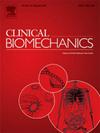直接缝合法修复滑轮的力学研究
IF 1.4
3区 医学
Q4 ENGINEERING, BIOMEDICAL
引用次数: 0
摘要
背景手指滑轮断裂是最常见的攀岩损伤之一。根据损伤的程度,可能需要进行手术治疗。传统技术屡试不爽,但它们都使用自体移植物来重建滑轮,并已观察到一些副作用。目前的技术是直接缝合受伤的滑轮,不使用自体移植物,足迹极小,愈合后腱骨距离正常。本研究旨在验证直接缝合修复的滑轮在术后的稳定性。试验首先在原生滑轮上进行,然后在缝合后的滑轮上进行。结果我们发现原生 A2 滑轮(334.9 牛顿)和缝合 A2 滑轮(59.0 牛顿)之间的力量以及所有其他参数都存在显著差异。解释这些结果表明,直接缝合是一种能使受伤滑轮正确定位以便再生的技术,具有良好的稳定性,但不能提供即时阻力。本文章由计算机程序翻译,如有差异,请以英文原文为准。
Pulley reparation with direct suture technique: A mechanical study
Background
One of the most common climbing injuries is finger pulley ruptures. Depending on the grade of injury, surgery may be required. Conventional techniques are tried and tested, but they all use autograft to reconstruct the pulley and some side effects have been observed. The present technique, direct suture of injured pulleys, not using autograft, has a minimal footprint and a normal tendon-bone distance after healing. This study aimed to verify the post-operative stability of the pulley repaired with direct suture.
Methods
We performed rupture tests on the pulleys of 17 cadaver fingers via traction on the flexor tendons. Tests were carried out first on the native pulley and then on the sutured pulley. We measured the total tensile force and fingertip force and calculated the force of the A2 and A4 pulleys in each test.
Findings
We found a significant difference in force between native (334.9 N) and sutured (59.0 N) A2 pulleys and in all other parameters.
Interpretation
These results showed that direct suturing is a technique that allows the injured pulley to be properly positioned for regeneration with good stability but does not provide immediate resistance.
求助全文
通过发布文献求助,成功后即可免费获取论文全文。
去求助
来源期刊

Clinical Biomechanics
医学-工程:生物医学
CiteScore
3.30
自引率
5.60%
发文量
189
审稿时长
12.3 weeks
期刊介绍:
Clinical Biomechanics is an international multidisciplinary journal of biomechanics with a focus on medical and clinical applications of new knowledge in the field.
The science of biomechanics helps explain the causes of cell, tissue, organ and body system disorders, and supports clinicians in the diagnosis, prognosis and evaluation of treatment methods and technologies. Clinical Biomechanics aims to strengthen the links between laboratory and clinic by publishing cutting-edge biomechanics research which helps to explain the causes of injury and disease, and which provides evidence contributing to improved clinical management.
A rigorous peer review system is employed and every attempt is made to process and publish top-quality papers promptly.
Clinical Biomechanics explores all facets of body system, organ, tissue and cell biomechanics, with an emphasis on medical and clinical applications of the basic science aspects. The role of basic science is therefore recognized in a medical or clinical context. The readership of the journal closely reflects its multi-disciplinary contents, being a balance of scientists, engineers and clinicians.
The contents are in the form of research papers, brief reports, review papers and correspondence, whilst special interest issues and supplements are published from time to time.
Disciplines covered include biomechanics and mechanobiology at all scales, bioengineering and use of tissue engineering and biomaterials for clinical applications, biophysics, as well as biomechanical aspects of medical robotics, ergonomics, physical and occupational therapeutics and rehabilitation.
 求助内容:
求助内容: 应助结果提醒方式:
应助结果提醒方式:


